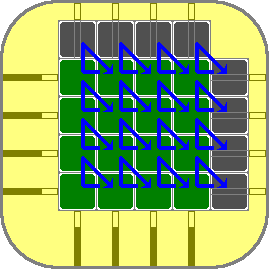


Crossover is a rare sliding piece puzzle made by Nintendo. The frame has a window that shows an arrangement of 16 tiles in a 4×4 square. Each row and each column has a slider in it that allows you to slide the row or column back and forth by one tile. Every slider actually contains 5 tiles, so whenever you do a move one tile is revealed and another becomes hidden. There are 24 tiles all together - 16 visible tiles and 8 hidden at the ends of the 8 sliders.
The most unusual feature of this puzzle is that the tiles and the transparent cover are polarised in such a way that a tile looks either dark green or light grey, and that its colour changes whenever it is moved. So whenever you slide a row or column, every tile that remains visible in that column will change from dark to light or vice versa. The aim is to make all tiles dark or all tiles light. There is a version with red tiles instead of green.
The puzzle is somewhat similar to the Uriblock / Mix Box and Tsukuda's Square (a.k.a 'It'). The puzzle is mentioned in Cubic Circular Issue 2, p9.
Each slider has two possible locations, so there are 28 arrangements of the sliders. There are 24 tiles, so for any state of the sliders there are at most 24! tile arrangements. This limit is not reached because there are only two types of tiles, 12 of each polarisation. This gives 24! / 12!2 = 2,704,156 tile arrangements. Combining this we get a total of 28 · 24! / 12!2 = 692,263,936 positions. All these positions can be attained.
A computer search gave the following result:
|
|
This shows that any position can be solved in at most 32 moves, where a move is sliding a single row or column and on average the optimal solution takes 16.6962 moves.

Suppose you slide a row, then a column, then slide the row back, and finally
slide the column back. The effect of such a manoeuvre is that three tiles
have been swapped around. The affected tiles are the one at the intersection
of the column and row, and the adjacent tiles that are moved into that
intersection. The picture on the right shows all possible 3-cycles that
occur this way. To move the three tiles of a particular triangle in the
picture, just alternately move the row and column that lie along the
triangle sides.

The picture on the right shows how the colours of the three tiles will change when you perform a 3-cycle. Note that a checkerboard arrangment of colours means that the three tiles are of the same type, and so switching them around will change nothing. Another thing to notice is that the number of dark squares does not change parity, i.e. it remains odd (1 or 3) or remains even (0 or 2).
With the above insight, it becomes fairly easy to solve the puzzle. Here is general description of the order in which I solve the puzzle.